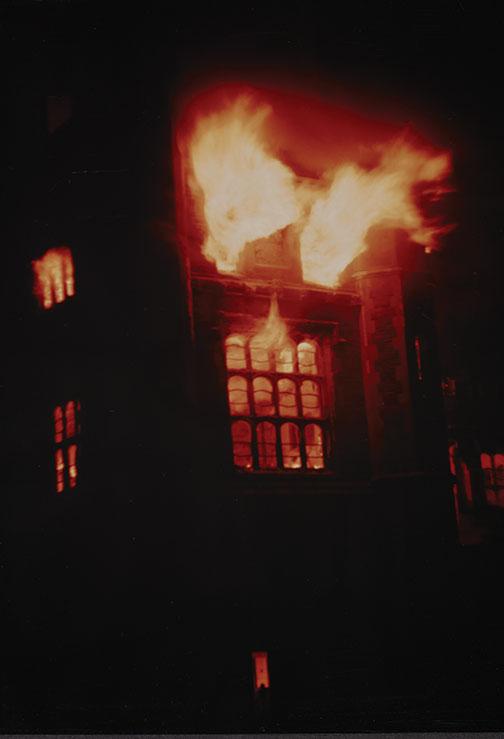
By the time of World War II, the 1903 gymnasium with its medieval-style buttresses seemed creaky and Victorian — but the University couldn’t afford to replace it. Instead, disaster struck, erasing priceless memories of sports triumphs past.
In wartime, the campus was home to 20,000 servicemen. The Navy occupied Little Hall next to the gym, where a sentry sounded the fire alarm at 2:45 a.m. on May 24, 1944.
Soldiers tumbled out of bed and converged at the gym, choking in smoky fog. Naval trainee Robert Clothier ’50 remarked on the “putrid smell of waxed wood (the basketball court) and burning rubber.”
No one knows where the fire started, but there was much to burn in the main hall as well as in the oak-paneled trophy room with its hammerbeam ceiling, a quaint place adorned with banners, stuffed tigers, and old footballs.
When Nassau Hall burned 89 years earlier, young heroes broke down the door to save priceless portraits. A similar attempt now nearly proved disastrous: As the students burst inside, the roof collapsed — just 45 minutes after the alarm sounded — and would-be rescuers were knocked backward by a sheet of flame.
“Ay! What a sight!” Clothier wrote home. “Flames were shooting skyward ... and inside the gym was just a red-hot inferno of flames. Windows were popping and flames were pouring out of them horizontally. ... All I could hear was the loud crackling of the fire and the sound of falling beams, timber and steel girders.”
Five fire departments came from as far away as Trenton but could do little. The next morning, Clothier wrote, “My eyes met such a confused tangle of metal girders, charred wood, beams, stone masonry, pipes, bits of roof, all pointed every direction possible. … And I had Phy. Ed. in it that afternoon, oh me.”
As a crowd of 1,000 gathered, armed guards were posted to protect melted bits of trophy metal inside, valuable in wartime. Embers glowed for days.
Every memento burned up, from Hobey Baker 1914’s hockey stick to the round football from the Yale-Princeton game in 1873. Also lost were 14 athletic murals that a noted artist had spent two-and-a-half years painting and a 2,500-volume library of sports and medicine, assembled over a lifetime by a retired staff member.
After the $500,000 loss, alumni rallied to rebuild, even passing the hat on a troopship off Normandy. Soon Dillon Gym would rise, incorporating fragments of the old gym’s fire-blackened walls.
